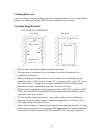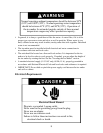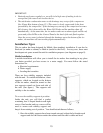
Water Supply
The water supply should be ready at the point of installation. The water supply pressure
should be a minimum of 15 psig with a static pressure not more than 80 psig. (A wall
outlet directly behind the ice maker will make installation easier.)
IMPORTANT:
1. All installations must be in accordance with local plumbing code requirements.
Professional installation is recommended.
2. Make certain that the hoses are not pinched or kinked or damaged during installation.
3. Check for leaks after connection.
Tools required: ½ in. open-end wrench, Phillips screwdriver
Connecting the water line:
1. Turn off main water supply. Turn on nearest faucet long enough to clear line of water.
2. Find a ½ in. to ¾ in. vertical cold water pipe near the installation location. The
distance should be less than 9 feet. The water supply hose provided with the ice
maker is about 9 feet long.
3. A shut-off valve must be installed to the main water supply. If the water pipe has a
plain piece of copper tubing, attach a ¼” O.D. compression union to the tubing and
remove the nut.
4. Connect nuts of the water supply hose to tap and water inlet valve. Tighten firmly by
hand, then one-half turn with wrench.
5. Turn on main water supply and tap. Check for water supply connection leaks. Tighten
every connection (including connections at the water inlet).
This type of ice maker does not require a drain line. The ice storage bin collects water
through ice cube melting. The water level of the ice storage bin can be seen through the
water level indicator tube. When required, the melt water must be discharged through the
melt water drainage nut on the front of the ice storage bin. The nut must be tightened
afterwards. (Do not loosen or screw off this nut at other times.) See Fig. A below.
12
Water level
Water level indicator tube
Melt water
drainage nut
Lower drainage nut
Water full probe
Compressor
Drainage
tray
Fig. A
Fig. B


















